Um plug-in específico do site permite que você adicione facilmente trechos de código ao seu site WordPress sem depender do seu tema. Ele permite que você use códigos personalizados para aprimorar seu site e não se preocupe em ter que refazer tudo quando o tema for atualizado.
No WPBeginner, criamos muitos plug-ins específicos do site para adicionar códigos de acesso, novos tipos de postagem e outros recursos ao nosso site no passado. Além disso, também ajudamos nossos clientes a começar a usar plug-ins específicos do site.
Neste artigo, explicaremos como criar um plug-in do WordPress específico para o site e por que ele é importante.
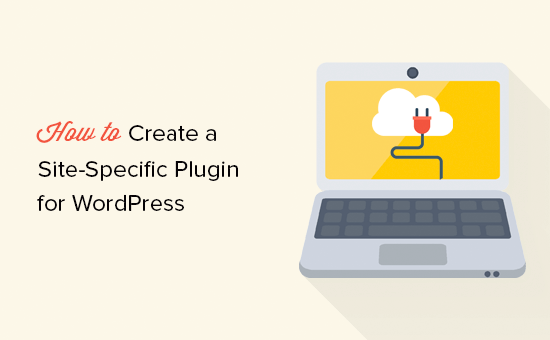
O que é um plug-in WordPress específico do site?
Um plugin WordPress específico do site é um plugin autônomo que pode ser usado para adicionar todos os trechos de personalização que não dependem do tema.
Ao trabalhar no seu site, você encontrará com frequência tutoriais do WordPress solicitando que você adicione código ao arquivo functions.php do seu tema ou a um plug-in específico do site.
O WordPress não vem com um plug-in específico para o site. Você precisará criar o seu próprio, instalá-lo e ativá-lo.
Por que criar um plug-in do WordPress específico para o site?
Como mencionamos anteriormente, você encontrará com frequência tutoriais que mostram alguns códigos que podem ser adicionados ao arquivo functions.php do seu tema ou a um plug-in específico do site.
Esses códigos personalizados podem ser usados para adicionar novos tipos de postagem, taxonomias, códigos de acesso e muitos outros recursos para aprimorar seu site.
Se você adicionar o código personalizado ao arquivo de funções do seu tema, ele desaparecerá se você atualizar ou trocar de tema.
Você pode criar um tema filho e usar o arquivo de funções do tema filho para salvar seu código. No entanto, seu código ainda desaparecerá se você trocar de tema.
Um plug-in do WordPress específico do site permite que você adicione facilmente trechos de código personalizados ao seu site do WordPress e garanta que eles sejam independentes do tema. É um plug-in autônomo do WordPress, o que significa que não depende do seu tema e que você pode atualizar ou trocar de tema.
Dito isso, vamos dar uma olhada em como adicionar facilmente o código personalizado usando um plug-in específico do site. Mostraremos duas maneiras de fazer isso, e você pode escolher o método que funciona melhor para você (dica: o método nº 2 é mais fácil para iniciantes).
Método 1: Criar manualmente um plug-in do WordPress específico do site
Sabemos que isso pode parecer um pouco nerd para os iniciantes, mas tentaremos simplificar ao máximo para você.
Primeiro, você precisa criar uma nova pasta na área de trabalho e dar a ela o nome do seu site. Por exemplo: mywebsite-plugin.
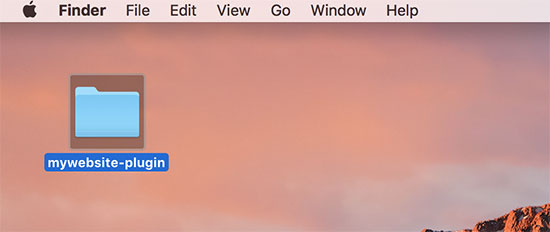
Agora, abra um editor de texto simples em seu computador, como o Notepad ou o TextEdit.
Você precisa criar um novo arquivo e salvá-lo como mywebsite-plugin.php na pasta do plugin em sua área de trabalho.
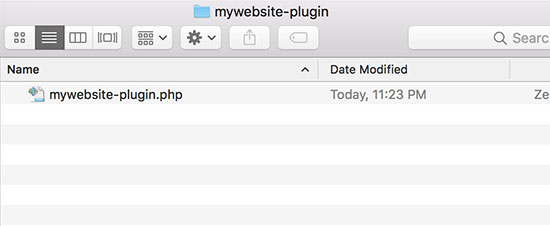
Seu arquivo de plug-in precisa de um código de cabeçalho específico para que o WordPress possa reconhecê-lo como um plug-in. Vá em frente e adicione o seguinte código ao seu arquivo mywebsite-plugin.php:
1 2 3 4 5 6 7 8 9 | <?php/*Plugin Name: Site Plugin for example.comDescription: Site specific code changes for example.com*//* Start Adding Functions Below this Line *//* Stop Adding Functions Below this Line */?> |
Você pode substituir example.com por seu próprio nome de domínio. Depois de fazer isso, seu plug-in específico do site estará pronto.
Há duas maneiras de carregar o plug-in específico do site em seu site. Você pode carregá-lo por meio do painel de administração do WordPress ou usar o FTP.
1. Instale o plug-in específico do site na área de administração do WordPress (recomendado)
Esse método é mais fácil e recomendado para todos os usuários.
Primeiro, você precisa criar um arquivo zip da pasta do plug-in específico do seu site.
Os usuários do Windows podem simplesmente clicar com o botão direito do mouse na pasta do plug-in e selecionar Send to ” Compressed (zip) folder.
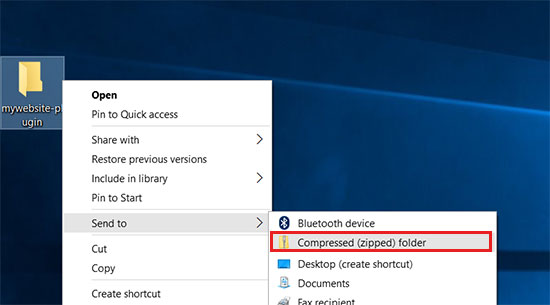
Os usuários de Mac precisam clicar com o botão direito do mouse.
Em seguida, selecione “Compress mywebsite-plugin”.
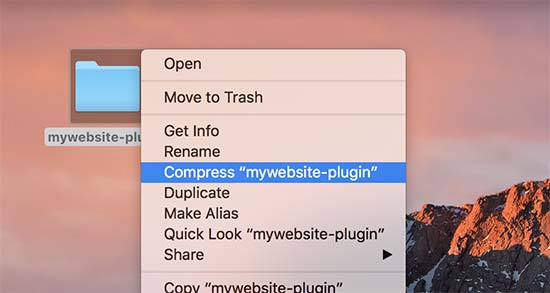
Depois de obter o arquivo zip do plug-in, vá para a página Plugins ” Add New (Adicionar novo ) na área de administração do WordPress.
Em seguida, clique no botão “Upload Plugin” na parte superior.
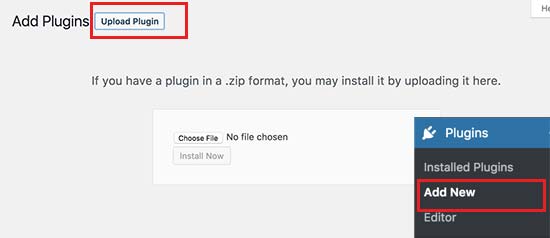
Em seguida, clique no botão “Choose File” (Escolher arquivo) para selecionar o arquivo zip criado anteriormente e, em seguida, clique no botão “Install Now” (Instalar agora).
O WordPress fará o upload e instalará o plug-in para você. Depois que ele for carregado, você precisará clicar no botão “Ativar plug-in” para começar a usar o plug-in específico do seu site.
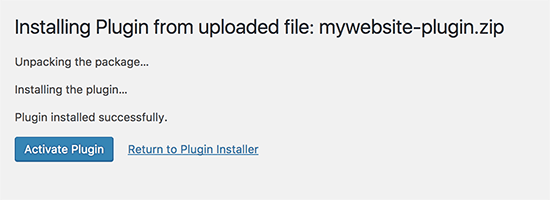
2. Faça upload do plug-in do WordPress específico do seu site via FTP
Para esse método, não é necessário criar um arquivo zip. Você fará o upload do plug-in via FTP.
Primeiro, você precisará se conectar ao seu site usando um cliente FTP.
Depois de conectado, vá para a pasta /wp-content/plugins/ na coluna do site remoto. Em seguida, você precisa selecionar a pasta de plug-ins específica do site e carregá-la em seu site.
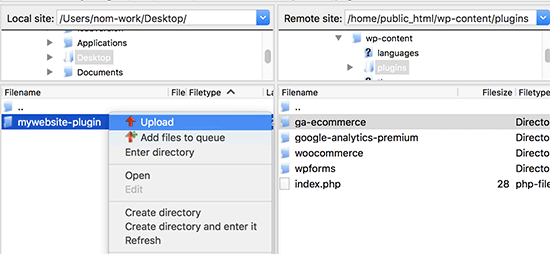
Seu cliente FTP agora transferirá a pasta do plugin específico do site para o site do WordPress. Isso instalará o plug-in em seu site.
No entanto, você ainda precisará ativar o plug-in para começar a usá-lo. Você pode fazer isso acessando a página “Plugins” na área de administração do WordPress e clicando no link “Ativar” abaixo do plug-in específico do site.
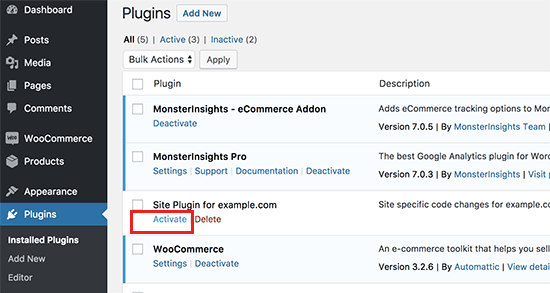
Isso é tudo. Seu plug-in específico do site está pronto para ser usado.
Adição de snippets de código personalizados ao seu plug-in específico do site
Há duas maneiras de editar seu plug-in e adicionar trechos de código personalizados a ele.
O primeiro método é fazer isso por meio da área de administração do WordPress. Você pode ir para a página Plugins ” Editor.
Você verá uma mensagem de aviso e precisará clicar no botão “I understand” (Eu entendo) para continuar. Como alternativa, se quiser uma maneira mais segura de editar os arquivos, pule para o segundo método abaixo.
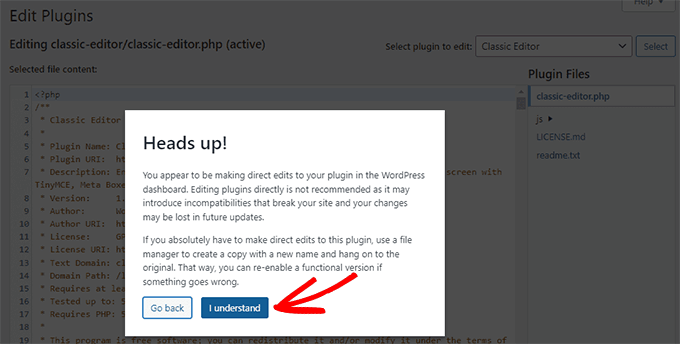
Em seguida, você precisa selecionar o plug-in específico do site no menu suspenso denominado “Select plugin to edit” (Selecionar plug-in para editar).
O editor carregará o arquivo do plug-in e você poderá adicionar trechos de código a ele.
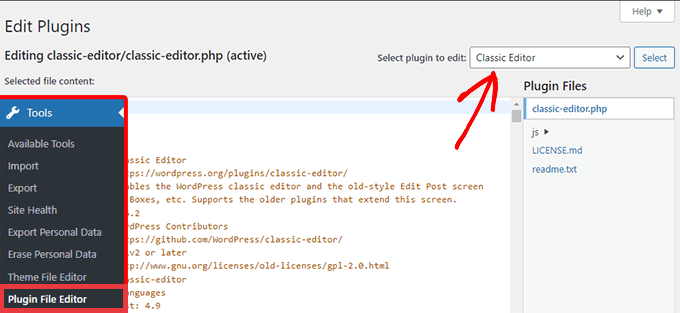
Quando terminar, clique no botão “Update File” (Atualizar arquivo) para salvar suas alterações.
Se houver algo faltando em seu código ou se houver a possibilidade de danificar seu site, o editor de plug-ins desfará automaticamente suas alterações.
No entanto, se o editor falhar e você vir a tela branca da morte, poderá usar o FTP para editar o arquivo do plug-in e desfazer essas alterações.
O segundo método é editar diretamente o arquivo do plug-in usando FTP. Basta acessar a pasta do plug-in usando seu cliente FTP. Clique com o botão direito do mouse no arquivo do plug-in e selecione “View/Edit” (Exibir/Editar).
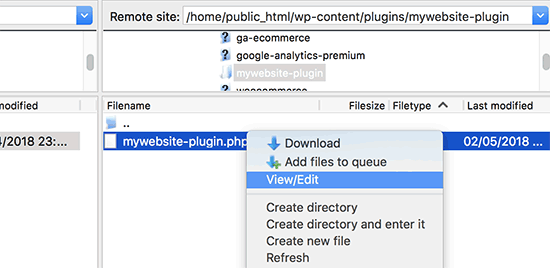
Você também pode fazer o download do arquivo do plug-in em seu computador, editá-lo e carregá-lo novamente.
Método 2: Adicionar código personalizado usando o WPCode (recomendado)
Esse método é muito mais simples e oferece uma maneira melhor de gerenciar seus trechos de código individuais no WordPress usando o WPCode.
A primeira coisa que você precisa fazer é instalar e ativar o plug-in gratuito do WPCode em seu site. Para obter mais detalhes, consulte nosso guia passo a passo sobre como instalar um plug-in do WordPress.
Postagem relacionada: Para obter mais informações, confira nossa análise completa do WPCode.
Após a ativação, o plug-in adicionará um novo item de menu denominado “Code Snippets” ao menu de administração do WordPress. Ao clicar nele, você será levado a uma página em que poderá gerenciar todos os seus códigos personalizados.
Para adicionar seu primeiro trecho de código, clique no botão “Add New” (Adicionar novo).
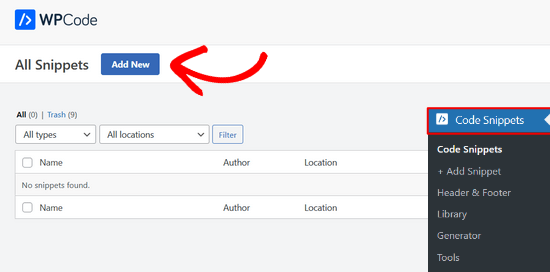
Isso o levará à página “Add Snippet”. Aqui, você pode escolher um trecho de código da biblioteca predefinida ou adicionar seu código personalizado.
Para adicionar o código personalizado, navegue até a opção “Add Your Custom Code (New Snippet)” (Adicionar seu código personalizado (novo snippet)) e clique no botão “Use snippet” (Usar snippet).
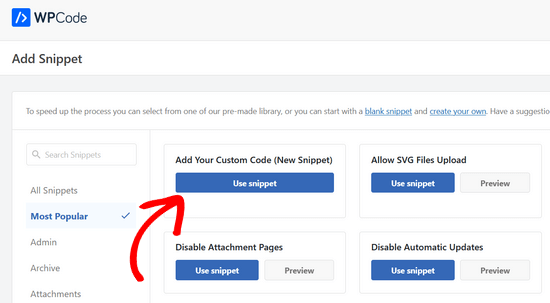
Agora, você pode inserir um título para seu snippet de código personalizado. Pode ser qualquer coisa que ajude você a identificar o código.
Depois disso, você pode ir em frente e colar seu snippet de código na caixa de código. Você também precisa selecionar o tipo “PHP Snippet” na lista suspensa “Code Type” (Tipo de código) à direita.
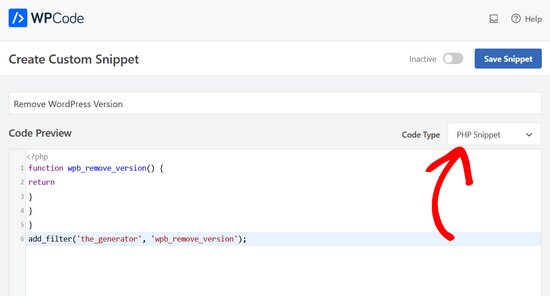
Você também pode adicionar notas ao código na seção “Informações básicas”.
Você deve usar essa área para escrever o que esse código faz, onde o encontrou e por que o está adicionando ao seu site. Isso ajudará o “futuro você” a lembrar por que o “passado você” adicionou esse código.
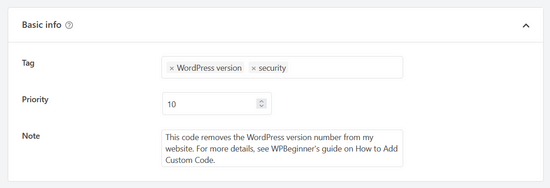
Você também tem a opção de atribuir tags aos seus trechos de código, o que pode ajudar a organizar os trechos de código por tópico e funcionalidade.
O plug-in também permite que você selecione como deseja executar o trecho de código. Na seção “Insertion” (Inserção), você pode selecionar o método “Auto Insert” (Inserção automática) para inserir e executar automaticamente o código no seu site.
Você pode escolher entre as opções da área de administração, front-end ou em qualquer lugar. Se você não tiver certeza, mantenha a opção padrão “Run Everywhere”.

Ou você pode escolher o método “Shortcode”. Com esse método, o snippet não é inserido automaticamente. Depois de salvar o snippet, você receberá um shortcode que poderá inserir manualmente em qualquer lugar do seu site.
Você também pode usar a seção “Lógica condicional inteligente” para mostrar ou ocultar trechos inseridos automaticamente com base em um conjunto de regras.
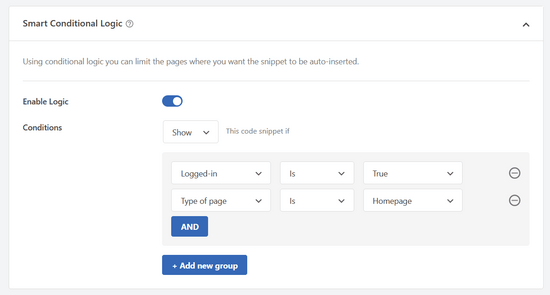
Por exemplo, você pode carregar trechos de código somente para usuários conectados, carregar trechos de código PHP somente em URLs de páginas específicas, mostrar trechos de código com base no tipo de página e muito mais.
Por fim, você pode alternar a chave de “Inativo” para “Ativo” e, em seguida, clicar no botão “Salvar snippet”.

Se você quiser salvar o snippet de código sem ativá-lo, clique apenas no botão “Save Snippet”.
Depois de salvar e ativar um snippet de código, ele entrará em vigor automaticamente em seu site, se esse for o método de inserção escolhido.
Para obter mais detalhes, consulte nosso guia sobre como adicionar facilmente snippets de código personalizados no WordPress.
Esperamos que este artigo tenha ajudado você a saber por que e como criar um plugin WordPress específico para o site. Talvez você também queira ver nossa lista de dicas úteis sobre arquivos de funções e os hacks mais procurados do WordPress para usar melhor seu plug-in específico do site.
Se você gostou deste artigo, inscreva-se em nosso canal do YouTube para receber tutoriais em vídeo sobre o WordPress. Você também pode nos encontrar no Twitter e no Facebook.





BSubra
Is it possible to add code snippets like Google Analytics Code, Adsense code in Site Specific Pliugin. Or only possible to add codes we generally put in functions.php file.
I mean, is it possible to add codes in site-specific plugin what we generally put in Header.php file.
WPBeginner Support
You can do that if you would like, you can also use the insert headers and footers plugin.
Admin
Bola Oussou
hi
Thanks for this tuto
however is there a way to make this plugging(not to be visible) not in plugging list and also in a specific folder (not wp-content folder) ?
Thanls
Tor-Bjorn Fjellner
Actually yes, there is:
Instead of placing the plugin in …/wp-content/plugins/ you put it in …/wp-content/mu-plugins/ (You may have to create that directory, if it’s not there yet.
Plugins that are placed in mu-plugins are ALWAYS run, so the only way to deactivate a MU plugin (MU currently is construed as “must use”) is to delete it (or remain the directly mu-plugins to something else…).
Judith
Hi I tried to do the Site-specific plugin, but it is not working, I get this message “The package could not be installed. No valid plugins were found.
Plugin installation failed.”
What do I do?
WPBeginner Support
Hi Judith,
This usually means that the plugin header information is incorrect. You can try again and make sure that your plugin header is exactly in the format displayed in the tutorial.
Admin
Jonathan Manheim
I get this same error. I have tried maybe 10 times. Uploaded through admin and on FTP. Cannot get it to upload. I am using TextEditor to paste the code. Notice several things you don’t mention in the post that I wonder could be an issue. First, won’t let me save the file as .php. I have to save it as .php.rtf OR .rtf then go back and rename the file after it is saved.
Second, not sure what you mean by making sure the format for the plugin header is exactly the same. Should the line number be in there? If so, I can’t get that to work. If I copy and paste with the line numbers, the green vertical line doesn’t show up and there is no space between the line numbers and the code. Or am I supposed to just copy the code (without the line numbers)? Either way, I’ve tried everything I can with my current Textedit application and it will not work.
Any ideas? I can send you screen shots of exactly what I have if you would like
WPBeginner Support
Hi Jonathan,
You will need to save file as .php. Please use a different text editor on Windows you can use Notepad or download Notepad++. On Mac, you can use TextEdit or download and install TextWrangler.
You don’t need to copy and paste line numbers.
Kacper
In my case the issue was that the file had Unicode encoding. Changing it to ANSI fixed the issue.
Ikram
Hi,
Good day!
Would like to know how to set a white paper in my blog post article to download it with add email address from the visitor.
Thanks, Ikram
WPBeginner Support
Hi Ikram,
You can do that with the pro version of WPForms. You will need at least Plus plan for that. After users enter their email address and click submit you can redirect them to the download page.
Admin
Alain Fradette
Great info! Thanks so much. I have been using WordPress for years and this little gem made it so much easier!
Abhijeet
I have edited some code in Style.css . Will it be overwritten if i update a theme?
is it possible to create style css file in this site specific plugin?
LFreitas
Yes, they will.
You should create a child theme and put your modifications there instead of in the original theme.
Read more: https://www.wpbeginner.com/glossary/child-theme/
dave
White screen on publishing pages.
The code works to show child pages on a parent page using the shortcode however I am getting white screen. Anyone know why?
Tommy
The plugin generated 3 characters of unexpected output during activation. If you notice “headers already sent” messages, problems with syndication feeds or other issues, try deactivating or removing this plugin.
Saurin
I believe best approach to add custom code to site is child theme. No matter if we need to customize theme or not. I mad a practice to always use child theme even if there is no customization. This habit saved my time & effort many times. I dont think it is good to create extra plugin for such customization.
I believe in minimum use of plugin no matter how simple you created one.
Jason
Which is better, site-specific plugin or Child Theme? or both?
I need to create a custom post type to add some major functionality to my site so is the plugin better or the child theme and its functions.php?
Thanks!
Josh
The thing is, is that you’re creating the plug-in yourself, using the functions the same exact way. So the answer to your question would be that neither is better, because you should be using them WITH each other.
Josh
Think of the site-specific plug-ins as functions that are independent of your theme.
Vickey
How would I create a create a new plugin directory in Azure? I have WordPress running on Azure using MS SQL Server, which I activated using Project NAMI.
vishal
not working on multisite with publisher theme can you help me this is my site and also tell me how can i remove featured image inside the post not from front page latest post
Nadia Khan
Hi there,
You WP Beginners are rock. and I want to thank you for your Struggles for us.
Now come to the point. I have installed an theme and in that theme, there is an function that is showing wp toolbar for guests, I have tried so many times to find this function in theme files to remove this, but i can’t. So please help me to remove that toolbar, that is showing to every visitor with wordpress logo and wordpress’s own link to their website. Screen Shot is attached.
Manuel
Does something like this work for plugins too? Im finding that I am making a few changes to plugins that I add to my site….many times deleting certain lines of code I dont want. I’m assuming that after I update that plugin, all my changes will be erased. How can I avoid this?
Elizabeth
Hi, thanks for the post. I’m getting an error when I activate the plugin for some reason:
Parse error: syntax error, unexpected ‘*’, expecting identifier (T_STRING) on line 9
Any ideas what I’ve done wrong?
Thanks!
WPBeginner Support
Hi Elizabeth,
There is an unexpected asterisk sign in the code on line 9 which is blocking the php script. Edit the file again and copy the code exactly as it is shown above. Make sure that you don’t copy line numbers in the code click on the Copy button at the top right corner of the code snippet box
.
Admin
Steven Denger
I tried naming the new folder as you did in the example but I got an error that said something in the way of you cannot use a name like this. This Instruction may be helpful to some – but it is very difficult and confusing to me and does not help at all. As I said – you need to explain this down to the fine details or otherwise these tutorals will not help. The name of this site is wp BEGINNER – and that is what I am. You project these tutorals to the more experienced.
I guess I will have to start going elswhere to get beginners instructiions because, most of time, wp beginner is not helpful – it is more like a techs only club.
Steven Denger
How do you get to the /wp-content/plugins/yoursitename-plugin/ in wordpress and upload a file there? I am lost on the first line of instruction. You guys always assume that we know these things in your instructions but they are not clear enough.
I went to cpanel and opened up the wpcontent > plugins – and it shows a list of plugins – but I am lost from this point. How do I go about uploading a file in here? I am a beginner – and you guys seem to always explain things like your instructing experienced techs. I am not but I go to WP Beginner to try to learn. It is usually difficult to follow your instructions and I end up having to go somewhere else in google search to find things explained down to a beginners level.
If you want to be more helpful try breaking things down a little more simple.
Manuel
Hey Steven,
I know the feeling! I’m far from a expert with wordpress and I pretty much live on google searches and this site trying to learn. I know a little bit and was able to get this to work. Send me your email and I’ll send you the steps with screenshots. I havent tested putting actual code into the plugin so we’ll see if that works….but I was able to see the newly created plugin on my admin page
Steven Denger
thank you manuel
NiceRazer
Hello, can you please tell me how to do that to? I’ve tried finding posts that would help me with this same prob but still didnt found it.
JoAnn Chateau
Thank you for the great advice and simple how-to instructions. I easily created a Site-Specific WordPress Plugin for my site and enabled shortcodes for widgets. Now I have less worry when changing themes, and I didn’t need to install another plugin. Again, thanks!
george
hi i followed the instruction on how to make a site plugin for my site. ive uploaded it but cant see it in my list of plugins.
any ideas why?
Dawn
I cannot find where the folders live in the plug in directory. I tried searching for: /wp-content/plugins/yoursitename-plugin/ (with my site name).
Kara
Never mind, I figured it out and got it activated. My hosting server was acting up, must have timed out or something…cheers!
Kara
I followed your instructions but i don’t know how to activate it. It doesn’t show in my list of plugind in my wp-admin. Can you help?
Sheyejinkazama
Thank you. Thank you so so much.
Molly
How do you get the plugin to “Network Activate” on a multi-site?
Stephanie
I’m getting the same error as Sonya above. Does anyone have a fix?
Parse error: syntax error, unexpected T_LNUMBER in /home/statisu0/public_html/wp-content/plugins/statisticshowto-plugin/statisticshowto.com-plugin.php on line 10
WPBeginner Support
your plugin file name contains .com in it. It should be statisticshowto.php instead.
Admin
Susan
Hi again. I’ve been reading through all of the comments above and, while some show your answer and resolution to the problem, many don’t. So it’s hard for me to learn from how others resolved their problems! Anyway, here’s what I’m wondering: if by following the instructions in this post to create a folder within my “plugins” folder, how will I be able to see my new site-specific plugin file?
For example, I followed the instructions to create a folder called susansinthegarden-plugin. Then I put my plugin code in a file called susansinthegarden-plugin.php. I can’t see the plugin when I go to plugins on my dashboard.
Is this because the new plugin text file exists in a sub-folder under “plugins”? I can’t figure out what I’m missing but really need to resolve this. Is there anyone out there who can help me? Thanks so much!
WPBeginner Support
No. Please make sure that your plugin’s header area is properly formatted.
Admin
emy
Hi,
What is a plugin header and how do I format it?
WPBeginner Support
Hey Emy,
The plugin header is the part that tells WordPress that this file should be treated as a plugin. It also tells WordPress the name of the plugin, version, and other information.
In the code shown above, the header part begins right after the first line and ends at line 5. It contains plugin’s title and description.
Susan
OK, I resolved my program. Not being a code-writer, I didn’t realize that there was a separate header to wrap around the code I was borrowing. Duh. Thanks for your help.
Susan
I followed your instructions to create a folder under wp-content/plugins etc. and put the file containing the code into that folder but I can’t see my new plugin when I go to my dashboard and look under plugins. Did I miss a step? Thanks in advance for your help!
Edgar Ramirez
Hello
I created the directory and the php file but i cannot see the plugin at all
/wp-content/plugins/yoursitename-plugin/
Open a blank file and save it as “yoursitename-plugin.php”
dont see it on the dashboard plugin list and neither in the Plugin>editor
Can you please help me
Sonia Lacasse
Never mind! Looks like I found the problem. Thanks for your awesome work!
Sonia Lacasse
When I try to activate the plugin, I get the following error message:
Plugin could not be activated because it triggered a fatal error.
Parse error: syntax error, unexpected ’06’ (T_LNUMBER) in /var/www/domain/wp-content/plugins/ETK-PLUGIN/ETK-PLUGIN.php on line 10
Can you please help?
Thanks!
Catherine Argyros
hi there, when i put this in the directory
I received this error message
The plugin generated 2 characters of unexpected output during activation. If you notice “headers already sent” messages, problems with syndication feeds or other issues, try deactivating or removing this plugin.
but my plug in is activated….. please help me understand what is going on?
thank you
WPBeginner Support
Most probable cause for this error could be an empty space after the last ?> closing tag.
Admin
error message
wonderful, thats exactly what the problem was. Thank you for helping me create my first plugin!
WPBeginner Support
Glad to help
xin a day
“All you have to do is create a new folder in the plugins directory. Example: /wp-content/plugins/yoursitename-plugin/
Open a blank file and save it as “yoursitename-plugin.php”
Put the following code in the file:”
i hv few question on these .
1. i can’t create a folder onthe plugin directory.
2. where to open a blank file ?
3. the plugin diretory cant install that file.
thank you
Sacha
Awesome idea! I’ve always found functions.php a pain, so this method works great!
Alan Shapiro
This is a really useful post–thank you! Perhaps someone else asked this and I just missed it in all the comments, but: will a site-specific plugin override a function that is in the theme’s functions.php? For instance, if there is a “remove_action” in the functions.php, will the same “add_action” in the plugin take precedence?
WPBeginner Support
Both functions.php file and site-specific plugin are treated as plugins. Functions.php file loads after plugins but they do not have precedence over eachother. This is why using the same function in both files can cause unexpected results. The best way to override pluggable code is by using hooks and filters.
Admin
Robert Masters
I’m building a plugin at the moment for a multisite network and I need certain functionality available only in specific sites, so this is a perfect article for me right now.
I have one question though…..how do I name the site plugin folder for a site that is created as a subdomain? Example: subdomain.mainsite.com would it be subdomain-mainsite-plugin or just subdomain-plugin?
Hope this makes sense, question based on your tutorial.
hans
very good. when you create a second instance don’t forget do give the “register and load” function an own name, like i did
Eric Ellis
That’s great. I always figured it was pretty simple. Thank you for the information.
Jide
Nice one there. Kindly update the post to inform readers that after activating the plugin, they will have to click on the “edit” link on the plugins page, to add their codes.
Most newbies might not know this…
WPBeginner Support
Actually we do not recommend editing plugins and themes from WordPress admin area. Instead, we would recommend editing your plugins in a text editor via FTP client. This way in case of an error you would be able to quickly fix it without losing access to admin area for too long.
Admin
Mark Holland
Thank you thank you thank you!! This has solved an issue that’s been puzzling me for weeks – and now solved in less than 1 minute.
Can’t express how grateful I am for you sharing your knowledge – thanks again!
Luca
Thank you for the advice! But now I’m confused: what’s the difference between this method and the plugin “Code Snippet”? Is the result the same? Or do they accomplish the same thing in a different way?
Malcolm
Three years later this post is still giving – It’s changed the way I think about customising wordpress – Thank you!
I tried this today and created a a site-specific-plugin with code to hide the wordpress menu bar for non-admins, and to add my latest post to a ‘Current issue’ menu item. Both worked perfectly.
But the third snippet I added to the plugin failed to work. When I copied the code to the child theme’s functions.php it worked as expected.
Can you explain why this would happen?
I’m trying to modify the effect of the plugin “Restricted Site Access” by allowing access to more than a single page. The code I tried in my site specific plugin and the functions.php was:
//
add_filter( ‘restricted_site_access_is_restricted’, ‘my_restricted_check’ );
function my_restricted_check( $is_restricted ) {
global $wp;
if (
$wp->query_vars[‘pagename’] == ‘contact’ ||
$wp->query_vars[‘pagename’] == ‘subscribe’ ||
$wp->query_vars[‘name’] == ‘aplr-2013-volume-21-number-2’
)
$is_restricted = false;
return $is_restricted;
}
Any advice or comment would be welcome. I’m confused!
harklord
after trying this. My site is opening blank… Please help.. Av tried deleting the files i created but still blank
WPBeginner Staff
Make sure that your stored the plugin’s php file in /wp-content/plugins/ folder and not in your theme directory.
Mohammed Amine
Fixed, actually it is necessary to add that php comment in the php file, or else it wont appear on the admin panel.
That php comment is used to show the discription of the plugin in the admin panel.
Paolo Bergomi
Hello,
This is Paolo, i am building my website and theme with WP last edition 4.1.1.
i Am trying to learn custom type fields and I found your website very useful. i hav ea issue, though: even if following this post i created the folder my theme plugin and with the related file .php you mentioned here, for the site specific plugin, copy all in localhost using WAMP server. i opened then my dashboard, went to plugins but my new plugin dont appear. what is going on? did i miss anything? thanks
paolo
WPBeginner Staff
You can try and fit your modifications in site-specific plugin by using filters. However, since you had to edit specific files we doubt that all your edits can be implemented in a site-specific plugin using filters. In that case you should make those changes into a child theme. All your custom CSS should also go into your child theme’s stylesheet. You can also use your site-specific plugin to enqueue a custom stylesheet.
Bas van der Linden
Hmm, looks like my last post went missing while registering for this annoying disqus plugin.
Anyways:
At first I’d like to thank you for sharing this information.
Secondly I do have several questions regarding this post.
1) Is it possible to also make site specific plugins for other .php’s where I’ve added some codes?
Such as front-page.php post-page.php and post-archives.php
2) Is it possible to do something like this for .css codes?
I run genesis as framework(Parent theme) and a child-theme that I’ve downloaded.
Now since there are no grand-child theme’s in wordpress I’ve made my alterations in the child-theme’s folder
This includes a lot of different .css edits, Is there a way to make site specific .css files/plugins like this, so I can maintain the origional child-theme (and perform an update if any updates are released)?
3) When I create a site-specific plugin to change the footer and activate it, I will see both the origional footer and my own footer on the site.
Is there a way to go around this?
My plugin looks like this:
Once again thank you for sharing this information on site-specific plugins, and I hope to hear soon from you guys.
Chelsey
Thank you for your patience… I’m still trying to figure out how to ‘create a new folder to plugins directory’
Rodney Lacambra
Hi Chelsey. Consider this guide:
Go to “File Manager”. It will take you to “/public_html” directory. Click on “wp-content >> plugins” . This is where you will “create” a folder called “yoursitename-plugin”. After that, create a file using some text editor(notepad++), paste the code given above and save the file as “yoursitename-plugin.php”. Upload it to “yoursitename-plugin” folder and activate it in your wordpress admin area. Easy as that!
Hope it helps you a lot.
Regards,
NomadTech
Benjamin Mukasa
This is a great post. I followed the instructions but the plugin is not appearing in my plugin list.
Paolo Bergomi
me same..where did we make wrong? thanks in advance for any tips to solve this
WPBeginner Staff
yes you can use it for multiple functions.
WPBeginner Staff
Your code seems to be correct. Here is what you can do:
Make sure you have saved the plugin file in the /wp-content/plugins/ directory.
Make sure that your plugin file name is correct. We recommend using yoursitename.php format. For example if your domain name is black-circles then your plugin file name should be black-circles.php
SteveMTNO
I originally had the plugin file (bc-plugin.php) in its own directory called blackcircles/wp-content/plugins/bc-plugins. That didn’t work.
Then I tried moving the bc-plugin.php file from that folder to the blackcircles/wp-content/plugins folder. Still doesn’t show up in my admin panel.
Do I have to “enable” it first before it shows up or something?
Confused….
WPBeginner Staff
If the file is correctly placed in your plugins folder then you will see it in your WordPress admin area under Plugins. If you see your plugin there, then you will have to click on the activate link below the file to activate the plugin.
Did you try renaming the file to something else?
SteveMTNO
Tried renaming it 3 times – none of them show up….
I must be doing something wrong (or not doing something that I should be doing)…
SteveMTNO
So can I use this one site-specific plugin for multiple functions, or is it best to do something similar to this for each one?
Michael Cuomo
I’m having a similar issue with mine. I’ve created a site specific plugin to create a custom content type, but the custom content type is not showing up in my admin panel underneath pages like it should.
SteveMTNO
I posted this yesterday, but it seems to have vanished…
Anyway, I followed the instructions above, but can’t see the site-specific plugin in my admin panel.
Here’s a link to my code:
http://pastebin.com/fbeGr8gh